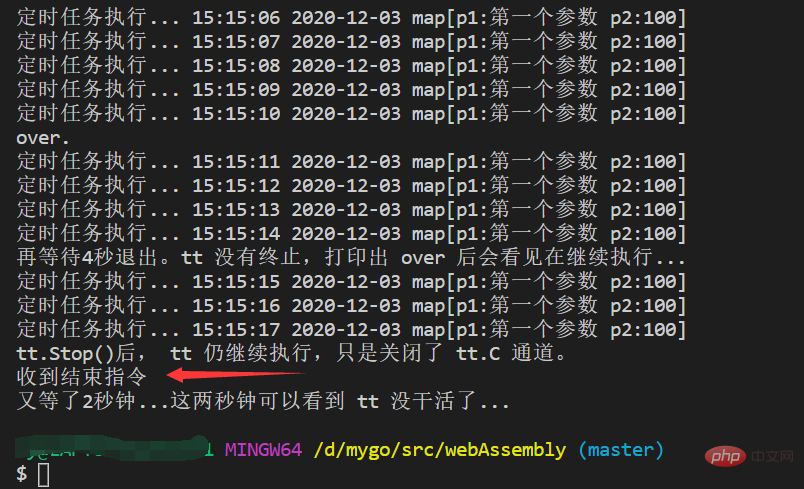Go 언어에서 타이머를 설정하는 방법
Go 언어에서 타이머를 설정하는 방법: 1. 설정된 간격에 따라 티커가 트리거되는 "time.NewTicker()" 메서드를 통해 생성합니다. 2. "time.NewTimer()를 통해 생성합니다. 타이머만 단어를 실행하는 " 메소드 3. "After()"를 사용하여 생성합니다.

이 글의 환경: Windows 7 시스템, Go1.11.2 버전, 이 글은 모든 브랜드의 컴퓨터에 적용됩니다.
추천: "golang 튜토리얼"
Go 언어의 타이머 사용
GO 언어는 시간 패키지에서 타이머를 사용하는 세 가지 방법을 제공합니다:
1. 첫 번째 유형 : ticker
// A Ticker holds a channel that delivers `ticks' of a clock
// at intervals.
type Ticker struct {
C <-chan Time // The channel on which the ticks are delivered.
r runtimeTimer
}는 time.NewTicker()를 통해 생성됩니다. 이 유형에서는 작업이 적극적으로 종료되지 않는 한 설정된 간격에 따라 티커가 계속 트리거됩니다.
2. 두 번째 유형: timer
// The Timer type represents a single event.
// When the Timer expires, the current time will be sent on C,
// unless the Timer was created by AfterFunc.
// A Timer must be created with NewTimer or AfterFunc.
type Timer struct {
C <-chan Time
r runtimeTimer
}은 time.NewTimer()을 통해 생성됩니다. 물론 타이머는 한 번만 실행됩니다. timer.Reset()을 호출하여 타이머를 다시 작동시키고 간격을 변경할 수 있습니다.
3. 세 번째 유형: After()
// After waits for the duration to elapse and then sends the current time
// on the returned channel.
// It is equivalent to NewTimer(d).C.
// The underlying Timer is not recovered by the garbage collector
// until the timer fires. If efficiency is a concern, use NewTimer
// instead and call Timer.Stop if the timer is no longer needed.
func After(d Duration) <-chan Time {
return NewTimer(d).C
} 코드에서 볼 수 있듯이 After()는 실제로 Timer의 구문 설탕입니다.
다음은 코드를 통해 세 가지 메서드를 사용하는 방법을 보여줍니다.
1.Ticker
ticker := time.NewTicker(time.Second * 1) // 运行时长
ch := make(chan int)
go func() {
var x int
for x < 10 {
select {
case <-ticker.C:
x++
fmt.Printf("%d\n", x)
}
}
ticker.Stop()
ch <- 0
}()
<-ch // 通过通道阻塞,让任务可以执行完指定的次数。티커는 1초마다 트리거됩니다. 즉, 매초마다 하나의 콘텐츠가 Ticker.C에 추가됩니다. 마지막으로 ch에 숫자를 써서 프로그램 차단을 해제하고 실행을 계속합니다.
2.Timer
timer := time.NewTimer(time.Second * 1) // timer 只能按时触发一次,可通过Reset()重置后继续触发。
go func() {
var x int
for {
select {
case <-timer.C:
x++
fmt.Printf("%d,%s\n", x, time.Now().Format("2006-01-02 15:04:05"))
if x < 10 {
timer.Reset(time.Second * 2)
} else {
ch <- x
}
}
}
}()
<-ch3.After()
// 阻塞一下,等待主进程结束
tt := time.NewTimer(time.Second * 10)
<-tt.C
fmt.Println("over.")
<-time.After(time.Second * 4)
fmt.Println("再等待4秒退出。tt 没有终止,打印出 over 后会看见在继续执行...")
tt.Stop()
<-time.After(time.Second * 2)
fmt.Println("tt.Stop()后, tt 仍继续执行,只是关闭了 tt.C 通道。")4. 이러한 기본 방법을 사용하여 자체 예약 작업 관리를 설계할 수 있습니다.
type jobFunc2 func(j *job)
type job struct {
jf jobFunc2
params map[string]interface{}
ch chan int
}
func NewJob() *job {
return &job{
params: make(map[string]interface{}),
ch: make(chan int),
}
}
func (j *job) Run(t time.Duration) {
ticker := time.NewTicker(time.Second * t)
go func() {
for {
select {
case <-ticker.C:
j.jf(j)
case <-j.ch:
fmt.Println("收到结束指令")
ticker.Stop()
break
}
}
}()
}
func main() {
j := NewJob()
j.jf = func(jj *job) {
fmt.Println("定时任务执行...", time.Now().Format("15:04:05 2006-02-01"), jj.params)
}
j.params["p1"] = "第一个参数"
j.params["p2"] = 100
j.Run(1)
// 阻塞一下,等待主进程结束
tt := time.NewTimer(time.Second * 10)
<-tt.C
fmt.Println("over.")
<-time.After(time.Second * 4)
fmt.Println("再等待4秒退出。tt 没有终止,打印出 over 后会看见在继续执行...")
tt.Stop()
<-time.After(time.Second * 2)
fmt.Println("tt.Stop()后, tt 仍继续执行,只是关闭了 tt.C 通道。")
}일부 실행 결과 스크린샷:

마지막으로 작업 실행이 채널을 통해 종료된다는 점을 덧붙이고 싶습니다.
// 阻塞一下,等待主进程结束
tt := time.NewTimer(time.Second * 10)
<-tt.C
fmt.Println("over.")
<-time.After(time.Second * 4)
fmt.Println("再等待4秒退出。tt 没有终止,打印出 over 后会看见在继续执行...")
tt.Stop()
<-time.After(time.Second * 2)
fmt.Println("tt.Stop()后, tt 仍继续执行,只是关闭了 tt.C 通道。")
j.ch <- 0
<-time.After(time.Second * 2)
fmt.Println("又等了2秒钟...这两秒钟可以看到 tt 没干活了...") 
GO 언어로 글을 쓸 때는 channel을 능숙하게 사용해야 합니다.
위 내용은 Go 언어에서 타이머를 설정하는 방법의 상세 내용입니다. 자세한 내용은 PHP 중국어 웹사이트의 기타 관련 기사를 참조하세요!

핫 AI 도구

Undresser.AI Undress
사실적인 누드 사진을 만들기 위한 AI 기반 앱

AI Clothes Remover
사진에서 옷을 제거하는 온라인 AI 도구입니다.

Undress AI Tool
무료로 이미지를 벗다

Clothoff.io
AI 옷 제거제

AI Hentai Generator
AI Hentai를 무료로 생성하십시오.

인기 기사

뜨거운 도구

메모장++7.3.1
사용하기 쉬운 무료 코드 편집기

SublimeText3 중국어 버전
중국어 버전, 사용하기 매우 쉽습니다.

스튜디오 13.0.1 보내기
강력한 PHP 통합 개발 환경

드림위버 CS6
시각적 웹 개발 도구

SublimeText3 Mac 버전
신 수준의 코드 편집 소프트웨어(SublimeText3)

뜨거운 주제
 7366
7366
 15
15
 1628
1628
 14
14
 1353
1353
 52
52
 1266
1266
 25
25
 1214
1214
 29
29
 Go 's Crawler Colly의 큐 스레드의 문제는 무엇입니까?
Apr 02, 2025 pm 02:09 PM
Go 's Crawler Colly의 큐 스레드의 문제는 무엇입니까?
Apr 02, 2025 pm 02:09 PM
Go Crawler Colly의 대기열 스레딩 문제는 Colly Crawler 라이브러리를 GO 언어로 사용하는 문제를 탐구합니다. � ...
 GO에서 플로팅 포인트 번호 작업에 어떤 라이브러리가 사용됩니까?
Apr 02, 2025 pm 02:06 PM
GO에서 플로팅 포인트 번호 작업에 어떤 라이브러리가 사용됩니까?
Apr 02, 2025 pm 02:06 PM
Go Language의 부동 소수점 번호 작동에 사용되는 라이브러리는 정확도를 보장하는 방법을 소개합니다.
 Goland의 사용자 정의 구조 레이블이 적용되지 않는 문제를 해결하는 방법은 무엇입니까?
Apr 02, 2025 pm 12:51 PM
Goland의 사용자 정의 구조 레이블이 적용되지 않는 문제를 해결하는 방법은 무엇입니까?
Apr 02, 2025 pm 12:51 PM
GO 언어 개발을 위해 Goland를 사용할 때 Goland의 사용자 정의 구조 태그 문제와 관련하여 종종 구성 문제가 발생합니다. 그들 중 하나는 ...
 GO의 어떤 라이브러리가 대기업에서 개발하거나 잘 알려진 오픈 소스 프로젝트에서 제공합니까?
Apr 02, 2025 pm 04:12 PM
GO의 어떤 라이브러리가 대기업에서 개발하거나 잘 알려진 오픈 소스 프로젝트에서 제공합니까?
Apr 02, 2025 pm 04:12 PM
GO의 어떤 라이브러리가 대기업이나 잘 알려진 오픈 소스 프로젝트에서 개발 했습니까? GO에 프로그래밍 할 때 개발자는 종종 몇 가지 일반적인 요구를 만납니다.
 이동 중에 왜 println 및 string () 함수로 문자열이 다른 효과를 갖는 이유는 무엇입니까?
Apr 02, 2025 pm 02:03 PM
이동 중에 왜 println 및 string () 함수로 문자열이 다른 효과를 갖는 이유는 무엇입니까?
Apr 02, 2025 pm 02:03 PM
Go Language의 문자열 인쇄의 차이 : println 및 String () 함수 사용 효과의 차이가 진행 중입니다 ...
 Go 및 Viper 라이브러리를 사용할 때 포인터를 전달 해야하는 이유는 무엇입니까?
Apr 02, 2025 pm 04:00 PM
Go 및 Viper 라이브러리를 사용할 때 포인터를 전달 해야하는 이유는 무엇입니까?
Apr 02, 2025 pm 04:00 PM
Go Pointer Syntax 및 Viper Library 사용의 문제 해결 GO 언어로 프로그래밍 할 때 특히 포인터의 구문 및 사용법을 이해하는 것이 중요합니다.
 GO 언어에서 'var'와 'type` 키워드 정의 구조의 차이점은 무엇입니까?
Apr 02, 2025 pm 12:57 PM
GO 언어에서 'var'와 'type` 키워드 정의 구조의 차이점은 무엇입니까?
Apr 02, 2025 pm 12:57 PM
GO 언어에서 구조를 정의하는 두 가지 방법 : VAR과 유형 키워드의 차이. 구조를 정의 할 때 Go Language는 종종 두 가지 다른 글쓰기 방법을 본다 : 첫째 ...
 BYTES.Buffer in Go Language가 메모리 누출을 유발합니다. 클라이언트는 메모리 사용을 피하기 위해 응답 본문을 어떻게 올바르게 닫습니까?
Apr 02, 2025 pm 02:27 PM
BYTES.Buffer in Go Language가 메모리 누출을 유발합니다. 클라이언트는 메모리 사용을 피하기 위해 응답 본문을 어떻게 올바르게 닫습니까?
Apr 02, 2025 pm 02:27 PM
바이트로 인한 메모리 누출 분석 Go Language에서 Go Language의 Makeslice, Bytes.Buffer가 문자열을 스플 라이스하는 데 사용되는 경우, 처리가 제대로 수행되지 않으면 ...




